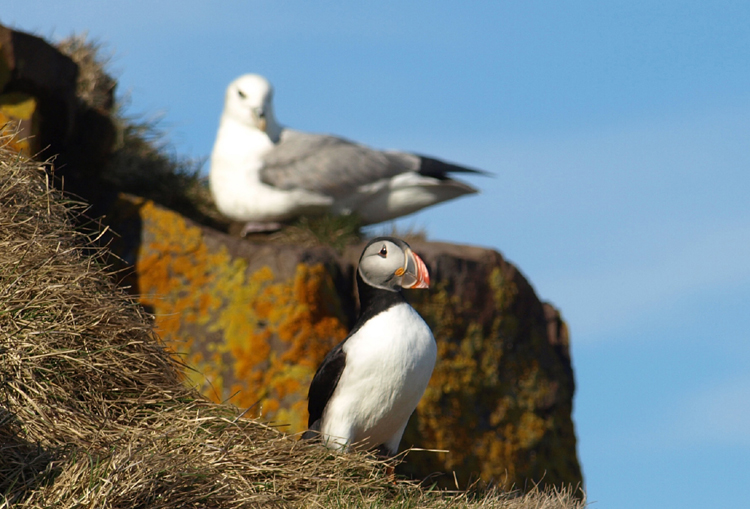Fulmar
 The Northern Fulmar (Fulmarus glacialis), or simply Fulmar, is a medium-sized seabird which bears a superficial resemblance to a gull, although Fulmars and gulls are not closely related. Fulmars breed on cliffs and in canyons. Fulmars lay a single egg on a narrow ledge. As is the case with most seabirds young Fulmars take a long time to fledge and they head out to sea as soon as they can fly.
The Northern Fulmar (Fulmarus glacialis), or simply Fulmar, is a medium-sized seabird which bears a superficial resemblance to a gull, although Fulmars and gulls are not closely related. Fulmars breed on cliffs and in canyons. Fulmars lay a single egg on a narrow ledge. As is the case with most seabirds young Fulmars take a long time to fledge and they head out to sea as soon as they can fly.
It is called fýll In Icelandic, mallemuk in Danish, havhest in Norwegian, stormfågel in Swedish, Eissturmvogel in German and Fulmar boréal in French.
According to the Environment Agency of Iceland between 3,300 and 10,500 Fulmars are hunted annually in Iceland. Fulmars were hunted rather heavily in the past in Iceland but are caught far less frequently nowadays.
The European Fulmar population is estimated to number between 2.8 million and 4.4 million pairs. Approximately 1-2 million pairs are estimated to breed in Iceland, with 1-5 million birds present over winter.
After a prolonged increase in the Icelandic Fulmar population, numbers are starting to decline again, a trend echoed elsewhere. The likely explanation for this decline is the decrease in zooplankton in the North Atlantic, one of the mainstays of the marine food chain. Despite the fluctuations in the Fulmar population, it remains a common breeder in Iceland, not least in eastern Iceland.
 More than 100 pairs of Fulmar breed at Hafnarhólmi but a lack of food in late summer means that only a few birds manage to fledge every year. Fulmars are most common along the coast but they also bred in inland cliffs and canyons. Fulmars have great difficulty in taking flight from flat land and if young birds misjudge their first take-off they can crash land and become stranded. Unless they can reach water or a cliff face they might fall prey to Arctic Foxes or starve to death.
More than 100 pairs of Fulmar breed at Hafnarhólmi but a lack of food in late summer means that only a few birds manage to fledge every year. Fulmars are most common along the coast but they also bred in inland cliffs and canyons. Fulmars have great difficulty in taking flight from flat land and if young birds misjudge their first take-off they can crash land and become stranded. Unless they can reach water or a cliff face they might fall prey to Arctic Foxes or starve to death.
Non-breeding Fulmars or failed breeders remain on their ledges to ensure that no other birds take over potential nest sites. Fulmars are long-lived birds and reach sexual maturity at around 11 years of age. In mild spells of weather in winter Fulmars often sit up on the bird cliffs as if they are checking the state of their nesting grounds. Fulmars frequently follow fishing vessels in the hope of snapping up whatever is thrown overboard.
Fulmars defend themselves by vomiting an oily liquid over aggressors. This is why Gyr Falcons are wary of Fulmars and every year Gyr Falcons need to be taken into care to be cleaned of Fulmar vomit. It is a common misconception that Fulmars project their vomit through the tubelike nostrils on top of the bill, as sometimes a drop of liquid can be seen in the nostrils. In fact Fulmars use the nostrils to excrete excess salt from their bodies in a saline solution.
